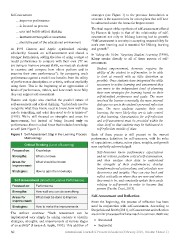Page 62 - International Journal of Process Educaiton (Special Issue)
P. 62
Self-assessment strategies (see Figure 1) to the previous formulation or
…improves performance structure is the nascent form for action plans that will later
…is focused on process be subsumed under the Areas for Improvement.
…uses and builds critical thinking
…increases metacognitive awareness The final aspect of the synthesis of self-assessment offered
…should be part of the educational environment by Hanson & Apple is that of the relationship of self-
assessment not only to lifelong learning but to growth:
In 1995 Hanson and Apple synthesized existing “Self-assessment is one step in accepting responsibility for
scholarship focused on self-assessment and shared a one's own learning and is essential for lifelong learning
stronger formulation, adding the idea of using a target or and growth.”
model performance to compare with their own (“If we
are trying to improve process skills, we must ask students In Taking the Helm: Targeting Student Learning (1996),
to examine and compare how others perform and to Klopp speaks directly to all of these aspects of self-
examine their own performance”). By comparing one’s assessment:
performance against a model one benefits from the utility
of performance descriptions or criteria, without explicitly Student empowerment, however, requires the
using them. This is the beginning of an appreciation of ability of the student to self-monitor, to be able
levels of performance, rubrics, and how much more fully to look at oneself with as little distortion as
they can support self-assessment. possible. Once students have integrated the skills
necessary to active learning and assessment they
Hanson and Apple also clarified the parallel nature of can move to the independent level of planning
self-assessment and critical thinking. “Individuals need to their own strategies for learning based on their
recognize what they know, need to know, how well they self-identified preferences and goals. The more
can do something, and what they need to do to improve” involved the learner is mentally, the more internal
(1995). We’re still focused on strengths and areas for dialogue occurs in the student's personal reflection
improvement, but instead of being focused only on time. The more students examine their own
performance, there is a dual focus that includes knowledge learning, the more likely they are to take control
as well (see Figure 1). of that learning. Opportunities for self-reflection
and self-assessment must be provided within the
Figure 1 Self-Assessment Step in the Learning Process class itself so that students may be habituated to
Methodology self-reflection outside of class.
Critical Thinking (Level of Learning) Each of these pieces is still present in the current
performance definition for self-assessors, with the roles
Focused on: Knowledge of expectations, criteria, action plans, insights, and growth
now explicitly acknowledged:
Strengths: What is known
Self-Assessors know performance expectations
Areas for What should be known and set criteria, perform critical self-examination,
and then analyze their data to understand
Improvement: the strengths of their performances, develop
transformational action plans, and articulate new
Strategies: How to gain the knowledge discoveries and insights. They can step back and
reflect critically on where they are now and where
Self-Assessment (Growth in Learner Performance) they want to be, and constantly update their goals
relating to self-growth in order to become that
Focused on: Performance person (Pacific Crest, 2013).
Strengths: How well one can do something Self-Assessment and Reflection
Areas for What must be done to improve From the beginning, the process of reflection has been
used in conjunction with self-assessment. According to
Improvement: Desjarlais and Smith (2011), self-assessment and reflection
are similar processes that have much in common. Both are:
Strategies: How to make the improvements
Structured
The authors continue: “Such assessment can be
implemented very simply by asking students to identify Sequential
strategies, strengths, and improvements at various stages
of an activity” (Hanson & Apple, 1995). This addition of
60 International Journal of Process Education (February 2016, Volume 8 Issue 1)

